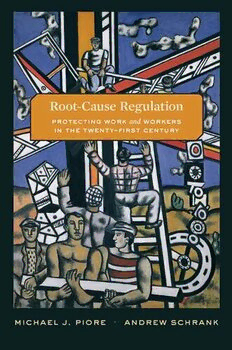
Root-Cause Regulation: Protecting Work and Workers in the Twenty-First Century PDF
Preview Root-Cause Regulation: Protecting Work and Workers in the Twenty-First Century
ROOT- CAUSE REGULATION Root-Cause Regulation Protecting Work and Workers in the tWenty-First century Michael J. Piore and Andrew Schrank Cambridge, Massachusetts London, England 2018 Copyright © 2018 by the President and Fellows of Harvard College All rights reserved Printed in the United States of Amer i ca First printing Library of Congress Cataloging- in- Publication Data Names: Piore, Michael J., author. | Schrank, Andrew, author. Title: Root- cause regulation : protecting work and workers in the twenty- first century / Michael J. Piore and Andrew Schrank. Description: Cambridge, Mas sa chu setts : Harvard University Press, 2018. | Includes bibliographical references and index. Identifiers: LCCN 2017036330 | ISBN 9780674979604 (hardcover : alk. paper) Subjects: LCSH: Labor laws and legislation. | Labor inspection— Law and legislation. Classification: LCC K1763 .P56 2018 | DDC 344.01— dc23 LC rec ord available at https:// lccn . loc . gov / 2017036330 Cover art: Composition for ‘The Constructors,’ 1950 (oil on canvas) by Fernand Leger | Private Collection | Bridgeman Images Cover design by Lisa Roberts To Rodney and to Aeron CONTENTS Preface, ix 1. INTRODUCTION, 1 2. T HE UNITED STATES, 18 3. FRANCE, 4 1 4. S PAIN, 62 5. L ATIN AMERICAN VARIANTS, 77 6. MANAGING DISCRETION, 102 7. DEVELOPING GUIDELINES, 1 28 8. CONCLUSION, 1 47 Notes, 165 References, 169 Index, 201 PREFACE This manuscript has been a long time in the making. It is the product of an extended chain of reflection and research. The chain stretches back to 1979, when a group of l abor inspectors arranged an informal dinner party in a textile town in northern France, once the cradle of the country’s in- dustrial revolution. The town had by then come to be inhabited almost entirely by foreign workers; they could be seen approaching and leaving the old mills at the end of each shift. But the party itself had been prompted by two t hings: (1) the debate about “ labor market rigidity” that was already under way at the time and that remains salient in con temporary France and (2) the requirement that the Ministry of Labor authorize large- scale layoffs in par tic u lar. While almost all of the requested layoffs were approved, the requirement was nonetheless disdained as a source of rigidity and con- tested by the business community— a seeming contradiction that prompted an obvious question: Why did business spend so much time combating a provision that seemed largely symbolic? As the officials who effectively au- thorized the layoffs, the inspectors resolved the apparent contradiction early in the eve ning when they revealed that, to obtain their approval, manage- ment had to invite them onto the premises for a site visit. But French l abor inspectors are responsible for the entirety of an extensive labor code, and once they were on- site they could examine virtually any aspect of the firm’s operation. What the inspectors actually reviewed, therefore, was entirely at their discretion, and this gave them enormous leverage over management. ix
